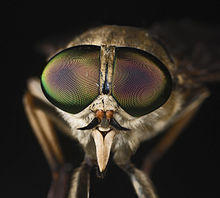
Horse-flies and deer flies are true flies in the family Tabanidae in the insect order Diptera. The adults are often large and agile in flight. Only female horseflies bite land vertebrates, including humans, to obtain blood. They prefer to fly in sunlight, avoiding dark and shady areas, and are inactive at night. They are found all over the world except for some islands and the polar regions. Both horse-flies and botflies (Oestridae) are sometimes referred to as gadflies.
Harold Oldroyd (24 December 1913 – 3 September 1978) was a British entomologist. He specialised in the biology of flies, and wrote many books, especially popular science that helped entomology to reach a broader public. His The Natural History of Flies is considered to be the "fly Bible". Although his speciality was the Diptera, he acknowledged that they are not a popular topic: "Breeding in dung, carrion, sewage and even living flesh, flies are a subject of disgust...not to be discussed in polite society". It was Oldroyd who proposed the idea of hyphenating the names of true flies (Diptera) to distinguish them from other insects with "fly" in their names. Thus, the "house-fly", "crane-fly" and "blow-fly" would be true flies, while the "dragonfly", "scorpion fly" and so on belong to other orders. He also debunked the calculation that a single pair of house-flies, if allowed to reproduce without inhibitions could, within nine months, number 5.6×1012 individuals, enough to cover the Earth to a thickness of 14.3 m (47 ft). Oldroyd calculated that such a layer would only cover Germany, but remarked "that is still a lot of flies".

Tabanus bromius, sometimes called the band-eyed brown horsefly, is a species of biting horseflies.

Tabanus autumnalis, the large marsh horsefly, is a medium-sized species of biting horse-fly. It is somewhat scarce compared to T. bromius and T. bovinus. This species shows slightly more of a preference for coastal marsh than some of the other European Tabanus, sometime even found in saltmashes. Wing length is 13–16 mm and about 16–22 mm in body length.

Tabanus cordiger also known as the plain-eyed grey horsefly is a species of biting horse-fly.

Tabanus glaucopis, also known as the downland horsefly, is a species of biting horse-fly.

Tabanus maculicornis also known as the narrow-winged horsefly is a species of biting horse-fly.
Tabanus miki also known as the plain-eyed brown horsefly is a species of biting horse-fly.
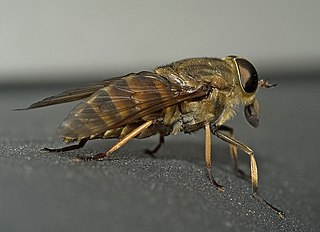
Tabanus sudeticus, also known as the dark giant horsefly, is a species of biting horse-fly. It is the heaviest fly in Europe.
Tabanus spodopterus also known as the black horned giant horsefly is a species of biting horse-fly. It is widespread in Europe, but only one doubtful specimen has been found in the United Kingdom.
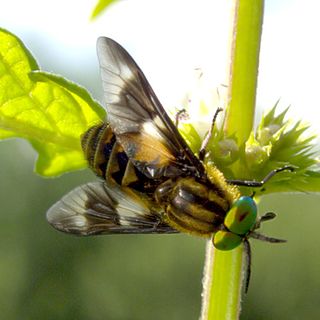
Superfamily Tabanoidea are insects in the order Diptera.

Tabanus eggeri is a Mediterranean species of biting horse-fly, found in southern France, Italy, Albania, Croatia, Herzegovina, Bulgaria, Portugal and Morocco. There are also unverified accounts of sightings in Spain and Israel.
Tabanus darimonti is a Mediterranean species of biting horse-fly. Only female specimens are known.

Haematopota pluvialis, the common horse fly or notch-horned cleg fly, or simply cleg in Scotland and northern parts of Ireland, is a species belonging to the family Tabanidae subfamily Tabaninae.
Cornelius Becker Philip (1900–1987) was an American entomologist, noted for assigning comedic names to species he described.
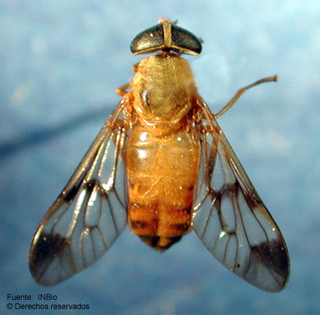
Diachlorus is a genus of biting horseflies of the family Tabanidae. D. ferrugatus ranges from the southeastern United States to Costa Rica. There are 27 species with a neotropical distribution, with the greatest diversity in Brazil, while 3 are found in Central America.
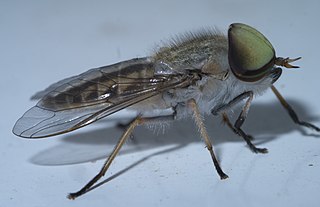
Tabaninae is a subfamily in the family Tabanidae commonly known as horse flies. There are more than 3000 described species in Tabaninae.
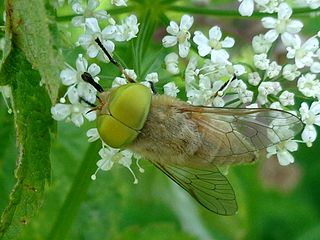
Atylotus is a genus of horse flies in the family Tabanidae.
